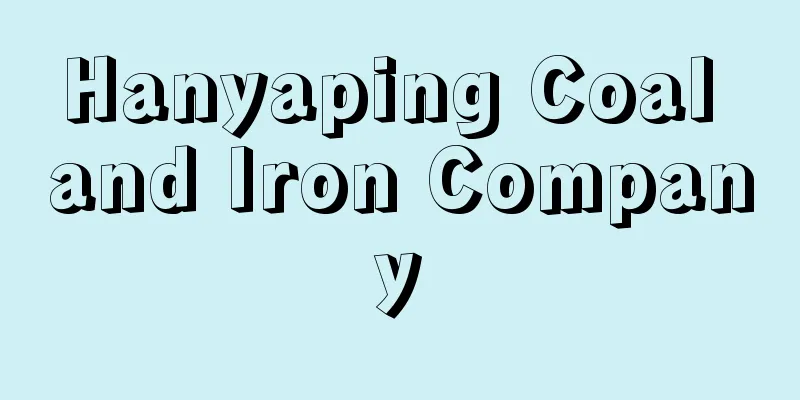Hanyaping Coal and Iron Company

|
A large steel company in China. It was the predecessor of the current Huazhong Iron and Steel Company's Daye Steel Factory. It managed the Hanyang Iron Works and Daye Iron Mine in Hubei Province, and the Pingxiang Coal Mine in Jiangxi Province. It originated from the government-run Hanyang Iron and Steel Bureau, which was established in 1891 at the end of the Qing Dynasty under the initiative of Zhang Zhidong. In 1897, it was transferred to an official business office managed by Sheng Xuanhuai, and in 1908 it became the privately-run Hanye Ping Coal and Iron Company (official capital 20 million yuan, general manager Sheng Xuanhuai). After that, they introduced large amounts of yen bonds through the Industrial Bank of Japan (now Mizuho Bank and Mizuho Corporate Bank), Yokohama Specie Bank (later the Bank of Tokyo, now Mitsubishi UFJ Bank), and other banks, and in 1912 they signed a provisional agreement for a Japan-China joint venture, but it was rejected at the general shareholders' meeting. Japan also asserted its interests in the Twenty-One Demands. In 1922, they built the Daye Steel Works at the limestone shipping port of Daye Mine (now Huangshi), and in 1928 they separated the Pingxiang Coal Mine. In 1930, the Yahata Steel Works took over Japan's loans, and China became more dependent on the Daye Mine. During the Second Sino-Japanese War, the mine was seized by the Japanese military and placed under the control of Nippon Steel Corporation. After the founding of the People's Republic of China, Hanyang became part of the city of Wuhan, and a huge industrial complex called the Wuhan Iron and Steel Company was built on the outskirts, making it one of the centers of heavy industry in China. The successor to the Daye Steel Works, Daye Steel Plant, was renowned for the production of high-grade and special steel, and in 1993 it became Daye Special Steel Co., Ltd. [Makio Okabe, August 21, 2018] [Reference item] | | |Source: Shogakukan Encyclopedia Nipponica About Encyclopedia Nipponica Information | Legend |
|
中国に存在した大製鉄企業。現在の華中鋼鉄公司大冶鋼廠(だいやこうしょう)の前身。湖北(こほく)省の漢陽(かんよう)製鉄所、大冶鉄山、江西(こうせい)省の萍郷(へいきょう)炭鉱を一括経営した。清朝末期の1891年、張之洞(ちょうしどう)の主導で設立された官営漢陽鉄政局を母体とする。1897年盛宣懐(せいせんかい)経営の官督商弁に移り、1908年民営の漢冶萍煤鉄公司(公称資本金2000万元、総弁盛宣懐)となった。以後、日本興業銀行(現、みずほ銀行およびみずほコーポレート銀行)、横浜正金(しょうきん)銀行(のちの東京銀行。現、三菱(みつびし)UFJ銀行)などを通じ多額の円貨債を導入し、1912年には日華合弁の仮契約を締結したが、株主総会で否決された。日本は二十一か条要求においても権益を主張した。1922年、大冶鉱の積出し港石灰(せっかいよう)(現、黄石(こうせき))にも大冶製鉄所を建設し、1928年萍郷炭鉱を分離した。1930年には日本側の借款を八幡(やはた)製鉄所が肩代りし、大冶鉱への依存を強めた。日中戦争の間は日本軍が接収、日本製鉄の管理下に置いた。中華人民共和国成立後、漢陽は武漢(ぶかん)市の一部となり、郊外に武漢鋼鉄公司という一大コンビナートが建設され、中国重工業の一中心地になった。大冶製鉄所の後身、大冶鋼鉄廠は、高級・特殊鋼の生産で名高く、1993年に大冶特殊鋼股份(こふん)有限公司となった。 [岡部牧夫 2018年8月21日] [参照項目] | | |出典 小学館 日本大百科全書(ニッポニカ)日本大百科全書(ニッポニカ)について 情報 | 凡例 |
Recommend
Damas, L. (English spelling) DamasL
...This trend eventually sparked a rebellion amon...
Persian Letters (English: Lettres persanes) French
An epistolary novel by Montesquieu, published in ...
Nikko - Nikko
1532-1598 A monk from the Sengoku to Azuchi-Momoy...
AKZO
...Others include the pharmaceutical industry in ...
Federation of Malaya - Malayarenpo (English spelling) Federation of Malaya
Predecessor state of the Federation of Malaysia Br...
I -
〘noun〙① Buddhist term. The entire human individual...
Kokoro - Heart
A full-length novel by Natsume Soseki. It was ser...
Paulinus (of Pella)
A nobleman from Burdigala (now Bordeaux) in Gaul, ...
Kamedayu Shinto Ritual - Kameyu Shinto Ritual
…Regular festival is held on October 14th. Specia...
Pendzhikent (English spelling)
The remains of a 6th-8th century Sogdian capital c...
Cadenza (English spelling) cadenza (Italian)
Musical term. (1) Harmonic cadence. There are thr...
Star
〘 noun 〙 (star)① A star. A star symbol. A star mar...
Ehagoita - Ehagoita
...Hago (hago) and koginoko (kogino ko) are the f...
Trial in absentia
〘noun〙① A trial in which the defendant is absent. ...
Muto Suke - From Muto Suke
Year of death: 25th August, 1228 (24th September, ...









